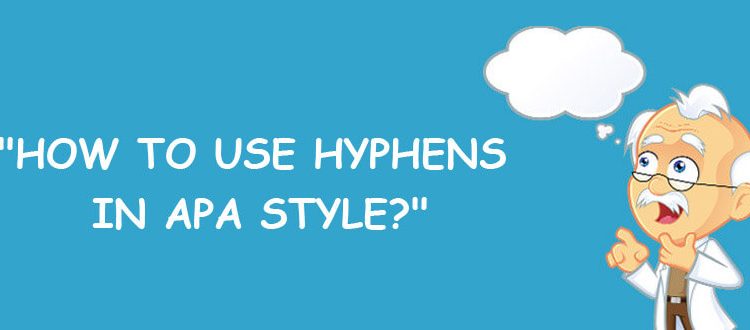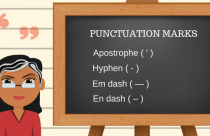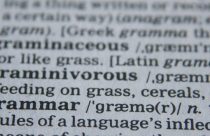Using Hyphens in APA Style in Academic Writing

Submitting a manuscript for publication in international journals can be a daunting task, especially for those whose native language is not English. Academic papers must follow specific protocols and author guidelines, and the information must be presented clearly and succinctly. To that end, authors rely on style guides to provide guidance on syntax, formatting, and punctuation. There are several different style guides, with the main differences being the formats for citations and references. The protocols on syntax and punctuation are fairly standard across all of them, with some exceptions.
The American Psychological Association (APA) publishes its Publication Manual of the American Psychological Association, a commonly used reference tool for academic writing worldwide and used in the social sciences and engineering disciplines. It was created approximately 80 years ago to “establish sound standards of communication.” APA’s rules help authors ensure that their writing is clear and concise and also help them to use proper punctuation with phrases that might otherwise be confusing to the reader.
One area that even authors often find confusing is when to include or omit hyphens in English writing. The material presented here outlines the APA rules for hyphen usage and will help clear up any confusion.
Using Hyphens with Prefixes
In most cases, the APA Style dictates that there is no hyphen after the prefix; however, there are some exceptions, especially with technical terminology. If a word has the same spelling but different meanings, it might be prudent to use a hyphen after the prefix to differentiate them. For example, recreation and re-creation have different meanings, one being a fun activity and the other being to create again. A hyphen is necessary in this case. Below is a short list of rules for prefix hyphenation.
A hyphen after the prefix is needed as follows:
- The word could be misread (see above example)
- The prefix is followed by double vowels (e.g., aa, ii, oo, or uu)
- A proper noun follows the prefix (e.g., un-American)
- A numeral follows the prefix (e.g., mid-2016)
- The words are always hyphenated (e.g., foot-candle)
- A prefix is added to a compound word that is already hyphenated (e.g., post-glacial-period climate)
- If “self” is the prefix (e.g., self-taught), a hyphen always follows
Using Hyphens with Compound Adjectives
An adjective is a word that describes or “modifies” a noun, such as a tall tree or blue sky. A compound adjective comprises two or more adjectives strung together to modify a noun, such as light-blue sky or hard-hearted person. These adjectival forms are usually hyphenated as well; however, there are some exceptions depending on the meaning of the phrase and whether it can be misinterpreted. For example, a light-blue-gray sky or a five-year-old girl are clearly defined; however, five-day trips and five day trips have different meanings, one being trips for five days and the other being five trips for one day each. A great way to reduce any ambiguity would be to rearrange the phrase and place the adjective after the noun (e.g., “five trips for one day each”). In academic writing, this is especially important, particularly given that the terminology might be uncommon.
Knowing whether a modifier is a compound or independent adjective can get a bit tricky for some. A good test is to use each on its own before the noun. In the example, clear concise language, we could put each adjective by itself to get “clear language” and “concise language”, which obviously tells us that these are two independent adjectives. Another method is to use “and” between the two to determine whether it makes sense (“clear and concise language”). Therefore, no hyphen is necessary.
Modifiers with a Common Base
The APA Style also dictates that modifiers that have a common noun (i.e., a common base) are treated differently. These types of phrases often appear in academic writing, especially in strings of data. According to APA, the common base need not be repeated after each adjective. For example, instead of writing, “a five-year-old patient, a six-year-old patient, and a seven-year-old patient were among those in the study group,” we would write, “a five-, a six-, and a seven-year-old patient were among those in the study group” to avoid unnecessary repetition thereby, reducing redundancy.
Comparative and Superlative Adjectives and Adverbs Ending in “Ly”
Comparative adjectives are used to compare two nouns (e.g., “Escherichia coli is deadlier than the influenza virus”). They usually, but not always, end in “er” or can be preceded by “more” (e.g., “Escherichia coli is more deadly than the influenza virus”). Superlative adjectives compare three or more nouns and usually, but not always, end in “est” or can be preceded by “most” as in “Escherichia coli is the most deadly of the viruses.” Neither comparative nor superlative adjectives need to be hyphenated because the meaning is clear.
Adverbs modify adjectives and, in many cases, end in “ly”. For example, “It was a fully formed loaf of bread.” There is no misconception about the meaning of this sentence; therefore, there is no need to use a hyphen after the adverb.
Ranges
Hyphens should never be used in ranges of numbers. Instead, the word “to” is preferred in the social science and engineering disciplines (e.g., “5 to 10 mL” not “5-10 mL”). This rule differs with the life sciences; therefore, the journal’s author guidelines should be consulted.
Five General Principles of Hyphenation
APA lists five general principles of hyphenation in an easy-to-understand format. This covers all the topics we’ve discussed and can be found here. You can also access the Merriam-Webster dictionary online, although the APA principles are the most recent.









